Effective Ant Control Strategies: Keeping Your Home Pest-Free

Ants, those industrious and intriguing insects, can be both a source of wonder and exasperation. While they play vital roles in our ecosystem, their unwelcome presence in our living spaces can lead to significant frustration. These tiny invaders can infiltrate our homes, raiding our pantries, and leaving behind trails on our kitchen countertops. To regain control over our living spaces, it’s crucial to equip ourselves with effective ant control strategies that protect our homes and maintain a pest-free environment.
Identifying Common Ant Species: Know Your Enemy

Ants, those tiny yet remarkably persistent insects, possess a knack for infiltrating our homes with surprising ease. To effectively combat these miniature intruders, it’s essential to comprehend the various ant species that commonly venture indoors. Each species boasts distinct characteristics, nesting habits, and preferred entry points, which offer valuable insights into effective pest control strategies. In this section, we will introduce and describe some of the most common ant species found in homes, shedding light on their peculiar traits and behaviors.
- Pavement Ants
 Pavement ants, aptly named for their tendency to nest beneath sidewalks and driveways, are frequent visitors in residential areas. These ants are small, measuring about 1/8 inch in length, and typically sport dark brown to black coloring. Their nests are recognizable by the small piles of displaced soil near their entrances. Pavement ants often invade homes in pursuit of sweet and greasy substances, exhibiting heightened activity during the warmer months.
Pavement ants, aptly named for their tendency to nest beneath sidewalks and driveways, are frequent visitors in residential areas. These ants are small, measuring about 1/8 inch in length, and typically sport dark brown to black coloring. Their nests are recognizable by the small piles of displaced soil near their entrances. Pavement ants often invade homes in pursuit of sweet and greasy substances, exhibiting heightened activity during the warmer months.
- Carpenter Ants
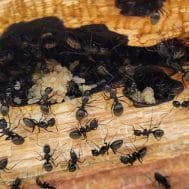 In contrast to their diminutive pavement ant counterparts, carpenter ants rank among the largest ant species, varying in size from 1/4 to 1/2 inch. These ants are infamous for their wood-boring tendencies, as they carve out galleries within wood to establish nests. Carpenter ants typically appear black, reddish, or a combination of both colors. Their presence within a home can indicate structural wood damage, with a preference for damp or decaying wood, making areas like bathrooms and basements susceptible.
In contrast to their diminutive pavement ant counterparts, carpenter ants rank among the largest ant species, varying in size from 1/4 to 1/2 inch. These ants are infamous for their wood-boring tendencies, as they carve out galleries within wood to establish nests. Carpenter ants typically appear black, reddish, or a combination of both colors. Their presence within a home can indicate structural wood damage, with a preference for damp or decaying wood, making areas like bathrooms and basements susceptible.
- Odorous House Ants
 Odorous house ants derive their name from the pungent, rotten coconut-like odor they emit when crushed. These ants measure around 1/16 to 1/8 inch in length and exhibit a distinctive segmented appearance. Known for establishing multiple colonies within a single home, odorous house ants can be a particularly persistent nuisance. They’re attracted to a wide range of foods and are often found in kitchens and pantries.
Odorous house ants derive their name from the pungent, rotten coconut-like odor they emit when crushed. These ants measure around 1/16 to 1/8 inch in length and exhibit a distinctive segmented appearance. Known for establishing multiple colonies within a single home, odorous house ants can be a particularly persistent nuisance. They’re attracted to a wide range of foods and are often found in kitchens and pantries.
- Argentine Ants
 Argentine ants are small, light to dark brown ants that frequently form extensive colonies near water sources. These ants demonstrate remarkable adaptability, capable of establishing massive super colonies with interconnected nests. Their preference for sweet substances makes them frequent kitchen invaders, while their knack for exploiting small cracks and crevices allows them easy entry into homes.
Argentine ants are small, light to dark brown ants that frequently form extensive colonies near water sources. These ants demonstrate remarkable adaptability, capable of establishing massive super colonies with interconnected nests. Their preference for sweet substances makes them frequent kitchen invaders, while their knack for exploiting small cracks and crevices allows them easy entry into homes.
- Thief Ants
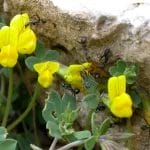 True to their name, thief ants are tiny and adept at pilfering food from other ants’ nests. These ants measure approximately 1/32 to 1/16 inch in length, sporting pale yellow to light brown coloring. Due to their small size, they often go unnoticed, and their preference for proteins and fats sets them apart from other ant species. Thief ants invade homes in search of food, making stored goods vulnerable to their scavenging. Understanding the unique characteristics, nesting habits, and entry preferences of these common ant species empowers homeowners with the knowledge needed to combat ant infestations effectively. By identifying the specific ant species invading your space, you can tailor your pest control measures to target their unique behaviors, ultimately creating a more ant-resistant living environment..
True to their name, thief ants are tiny and adept at pilfering food from other ants’ nests. These ants measure approximately 1/32 to 1/16 inch in length, sporting pale yellow to light brown coloring. Due to their small size, they often go unnoticed, and their preference for proteins and fats sets them apart from other ant species. Thief ants invade homes in search of food, making stored goods vulnerable to their scavenging. Understanding the unique characteristics, nesting habits, and entry preferences of these common ant species empowers homeowners with the knowledge needed to combat ant infestations effectively. By identifying the specific ant species invading your space, you can tailor your pest control measures to target their unique behaviors, ultimately creating a more ant-resistant living environment..
Understanding Ant Behavior: Unraveling the Trail
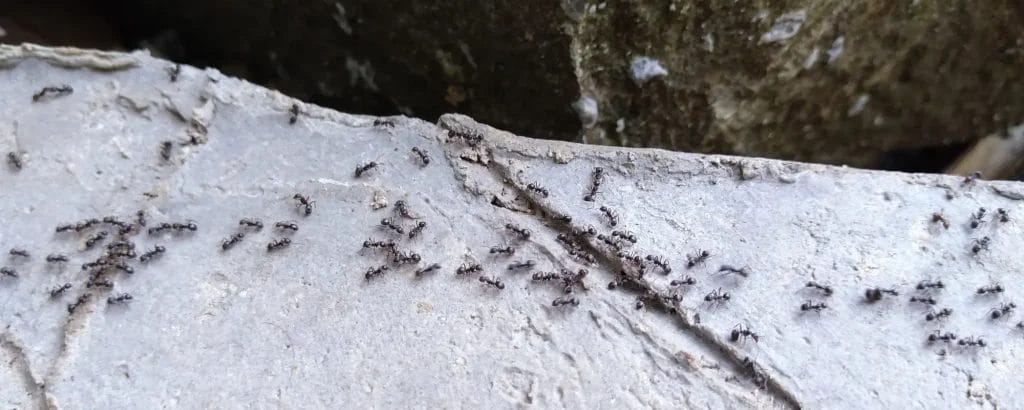 Ants, often perceived as solitary pests, operate with remarkable coordination and efficiency through intricate communication systems. To effectively combat ant infestations, it’s crucial to delve into their behavior, foraging patterns, and communication methods. By unraveling the secrets of these small yet social insects, homeowners can devise strategies that not only address immediate infestations but also thwart future incursions.
Ants, often perceived as solitary pests, operate with remarkable coordination and efficiency through intricate communication systems. To effectively combat ant infestations, it’s crucial to delve into their behavior, foraging patterns, and communication methods. By unraveling the secrets of these small yet social insects, homeowners can devise strategies that not only address immediate infestations but also thwart future incursions.
Foraging Behavior and Scent Trails: The Path to Success
 Ants are diligent foragers, constantly on the lookout for sources of food to sustain their colonies. When an ant discovers a viable food source, it doesn’t keep the treasure to itself. Instead, it leaves a chemical trail, known as a pheromone, while returning to the nest. This trail serves as a guide for fellow ants, leading them straight to the bounty. As more ants traverse the trail, the pheromone scent becomes stronger, creating a clear path for others to follow.
Ants are diligent foragers, constantly on the lookout for sources of food to sustain their colonies. When an ant discovers a viable food source, it doesn’t keep the treasure to itself. Instead, it leaves a chemical trail, known as a pheromone, while returning to the nest. This trail serves as a guide for fellow ants, leading them straight to the bounty. As more ants traverse the trail, the pheromone scent becomes stronger, creating a clear path for others to follow.
This behavior carries evolutionary advantages. By efficiently sharing information about food sources, ants minimize energy expenditure and maximize resource exploitation. However, this behavior poses a double-edged sword for homeowners, as it enables ants to quickly discover and exploit food within our living spaces.
Communication in the Ant World: The Dance of Information
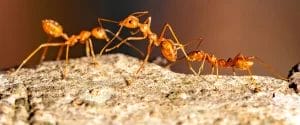 Ants don’t rely solely on scent trails for communication; they also engage in a variety of physical interactions to convey information. One intriguing example is the “antennation” behavior, where ants touch each other with their antennae. This action serves as a form of communication, often indicating social status, colony recognition, or even the exchange of information about potential food sources.
Ants don’t rely solely on scent trails for communication; they also engage in a variety of physical interactions to convey information. One intriguing example is the “antennation” behavior, where ants touch each other with their antennae. This action serves as a form of communication, often indicating social status, colony recognition, or even the exchange of information about potential food sources.
Another fascinating communication method is the “tandem running” behavior, where an experienced forager leads an inexperienced one to a food source. The experienced ant guides the novice by using its antennae to signal direction and distance, ensuring the efficient transfer of knowledge within the colony.
The Power of a Colony-Centric Approach: Targeting the Source
 When dealing with ant infestations, it’s tempting to focus solely on eliminating the visible ants and their trails. However, a more effective strategy involves targeting the entire colony. Ant colonies consist of a complex network of individuals, each playing a crucial role in the survival and success of the group. Merely eliminating foraging ants or destroying scent trails can provide temporary relief, but the colony’s resilience often leads to a swift return.
When dealing with ant infestations, it’s tempting to focus solely on eliminating the visible ants and their trails. However, a more effective strategy involves targeting the entire colony. Ant colonies consist of a complex network of individuals, each playing a crucial role in the survival and success of the group. Merely eliminating foraging ants or destroying scent trails can provide temporary relief, but the colony’s resilience often leads to a swift return.
To achieve long-lasting control, it’s essential to locate and eliminate the colony’s nest. This task may require a bit of detective work, as nests can be hidden within walls, under floors, or even outdoors. Once the nest is located, using targeted baits and treatments can significantly disrupt the colony’s ability to sustain itself.
Understanding ant behavior goes beyond recognizing their appearance and foraging trails. It delves into the intricate world of communication, organization, and teamwork that underlies their societal structures. By grasping these aspects, homeowners can adopt strategies that address ant infestations at their root, making their living spaces less appealing and hospitable to these tiny invaders. Remember, effective ant control is a battle not just against individual ants, but against the organized colonies that drive their persistence.
Health and Property Risks Posed by Ant Infestations
Ant infestations may appear inconsequential, but their presence in homes can introduce a range of health and property risks that demand attention. Beyond their nuisance value, ants can have far-reaching consequences that encompass both human well-being and structural integrity. Here are the key hazards to be aware of: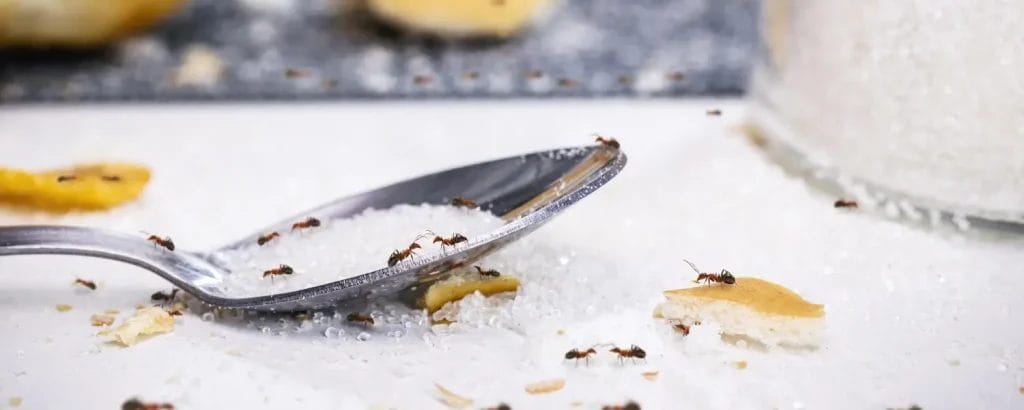
Food Contamination: A Silent Threat
- Ants are attracted to sugary, greasy, and edible materials in kitchens and pantries.
- They carry bacteria and pathogens from their outdoor excursions onto surfaces and food.
- Contaminated food can lead to gastrointestinal illnesses and pose health risks to residents.
Allergic Reactions and Stings: Unwanted Consequences
- Certain ant species, such as fire ants, deliver painful stings that can cause localized swelling and itching.
- Some individuals may experience severe allergic reactions to ant stings, necessitating medical attention.
- Pre-existing allergies or hypersensitivity can heighten the risk of adverse reactions.
Carpenter Ants: Undermining Structural Integrity
- Carpenter ants tunnel through wood to create nests, weakening the structural strength of wooden elements.

- Wooden structures at risk include beams, frames, and furniture.
- Over time, unchecked infestations can lead to significant property damage and costly repairs.
Mitigating the Risks
 Regularly clean and maintain kitchen and pantry areas to discourage ant foraging.
Regularly clean and maintain kitchen and pantry areas to discourage ant foraging.- Seal cracks, crevices, and entry points to keep ants from entering your home.
- Promptly address moisture issues and leaks, as damp wood attracts carpenter ants.
- Conduct routine inspections of wooden structures to identify carpenter ant infestations early.
- Consider professional pest control if infestations become challenging to manage.
By comprehending the multifaceted risks that ant infestations entail, homeowners can make informed decisions to safeguard both their health and property. Through a combination of preventative measures, vigilant monitoring, and timely intervention, the impact of ant-related hazards can be minimized, ensuring a safer and more secure living environment.
DIY Ant Prevention Tips: Effective Tips and Tricks to Rid Your Home of Pesky Ants
Ant infestations might seem overwhelming, but there are several proactive measures homeowners can take to deter these persistent pests. By adopting a combination of simple practices and natural deterrents, you can create an inhospitable environment that ants will think twice before invading.
Proper Food Storage and Hygiene

- Store food items in airtight containers to prevent ant access.
- Wipe down surfaces and clean up spills promptly to eliminate food traces.
- Regularly clean kitchen appliances, especially those with residues that attract ants.
- Empty trash bins regularly, as leftover food can lure ants indoors.
Seal Entry Points
- Inspect your home for cracks, gaps, and openings that ants can use to enter.
- Seal gaps around doors, windows, and utility lines using caulk or weather stripping.
- Pay attention to areas where utility pipes enter your home, as they can serve as entry points.
Maintain a Clean Environment

- Keep indoor and outdoor areas clutter-free to reduce potential nesting sites.
- Sweep and vacuum floors regularly to eliminate crumbs and food particles.
- Remove standing water sources, as ants are attracted to moisture.
- Trim vegetation and branches that can provide ants with easy access to your home.
Natural Deterrents
- Use white vinegar to clean surfaces, as ants don’t like the smell of its strong odor.
- Place natural repellents like lemon or orange peels at potential entry points.
- Essential oils such as peppermint, cinnamon, or eucalyptus can deter ants when applied along ant pathways or entry points.
Diatomaceous Earth and Baking Soda
- Sprinkle food-grade diatomaceous earth near entry points and ant trails.
- Mix equal parts of baking soda and powdered sugar and place it where ants are active.
- When ingested, these substances can harm ants without posing risks to humans or pets.
Keep Outdoor Areas Tidy
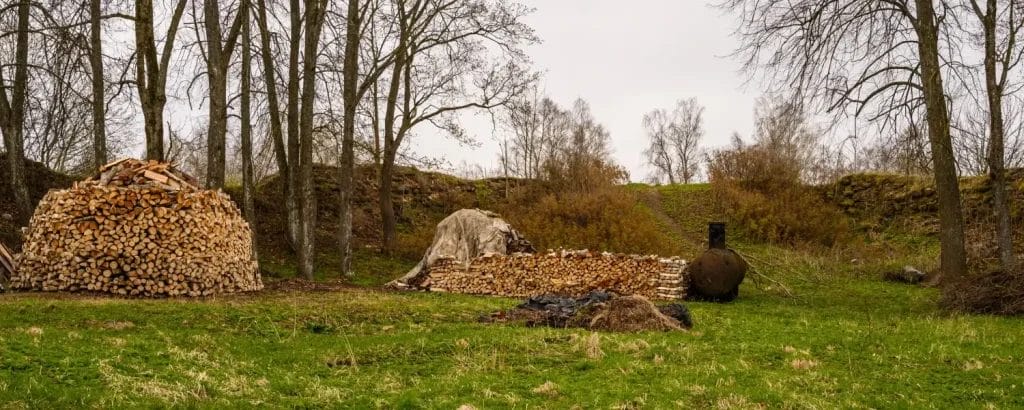
- Store firewood and other materials away from the house to eliminate potential nesting sites.
- Regularly clean outdoor trash bins to prevent ant attraction.
- Trim trees and shrubs away from your home’s exterior to reduce ant pathways.
Regular Maintenance Checks
- Perform routine inspections of your property for signs of ant activity.
- Address any moisture issues or leaks promptly to avoid attracting ants.
- Consider professional pest control services if DIY methods prove insufficient.
By integrating these DIY prevention tips into your routine, you can create a less appealing environment for ants and reduce the likelihood of infestations. Remember that consistency is key, as ant prevention is an ongoing effort that requires your vigilance and commitment. With these practices in place, you can confidently protect your home from the persistent advances of these tiny invaders.
Professional Pest Control: When to Seek Expert Help and Keep Your Home Ant-Free
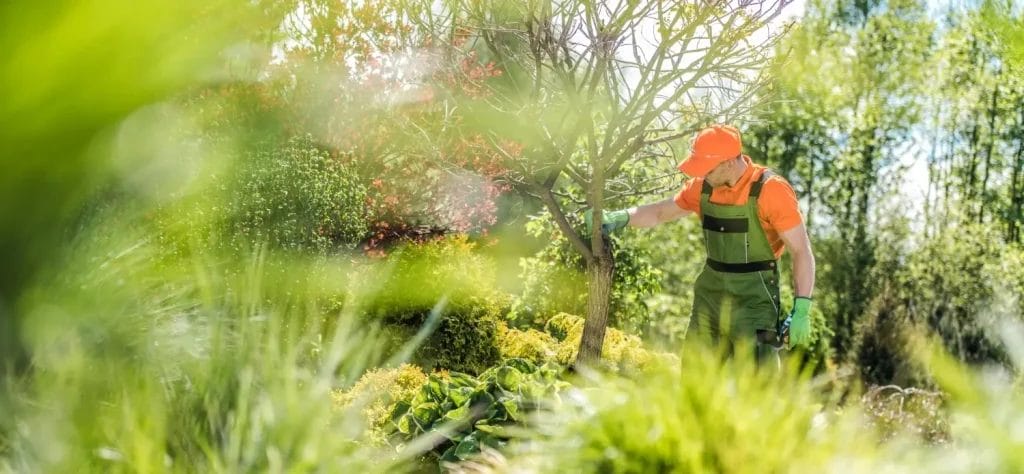
Professional ant control becomes necessary when you have a persistent ant infestation that home remedies or over-the-counter products cannot effectively manage. Ants are common household pests, and while some small ant problems can be handled with DIY methods, larger infestations or certain ant species may require the expertise of an ant pest control professional. Here are some signs that indicate it’s time to seek expert help for ant control:
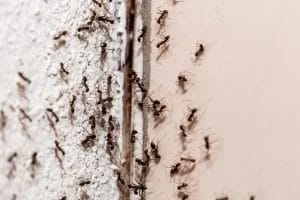
- Large or Multiple Colonies: If you notice multiple ant colonies in and around your home or business, especially if they are different ant species, it’s a sign that the infestation is extensive and may be beyond your ability to manage.
- Recurring Infestations: If ants keep coming back despite your best efforts to eliminate them, it could be an indication of a hidden, persistent nest that requires professional treatment.
- Destructive Ant Species: Some ant species, like carpenter ants, can cause structural damage to your property by tunneling through wood. Professional intervention is crucial to prevent long-term damage.
- Health and Safety Concerns: If the ants pose a health risk or safety hazard, such as fire ants with painful stings, it’s best to let professionals handle them to avoid potential harm.
- Allergic Reactions: If you, your family members, or pets have severe allergies to ant stings or bites, it’s essential to address the infestation promptly with professional help to minimize the risk.
- Hidden Nests: Ants often establish nests in hard-to-reach areas, such as inside walls or under foundations. Pest control experts have the tools and knowledge to locate and treat these hidden nests effectively.
 Unsuccessful DIY Efforts: If you’ve tried various DIY ant control methods, such as baits, traps, or sprays, and the infestation persists or worsens, it’s time to call in professionals who can identify the ant species and employ the most appropriate treatment methods.
Unsuccessful DIY Efforts: If you’ve tried various DIY ant control methods, such as baits, traps, or sprays, and the infestation persists or worsens, it’s time to call in professionals who can identify the ant species and employ the most appropriate treatment methods.- Commercial Properties: Businesses, restaurants, and other commercial properties cannot afford the reputation damage or health code violations that can result from an ant infestation. Professional pest control services are often required to maintain a pest-free environment.
- Environmental Concerns: Pest control professionals are trained to use pesticides safely and judiciously, minimizing harm to the environment and non-target species.
- Legal Regulations: In some regions, certain ant species are protected, and attempting to control them without professional guidance may be illegal. Professionals are aware of local regulations and can ensure compliance.
When seeking professional ant control services, it’s important to choose a reputable pest control company that is licensed, insured, and experienced in dealing with ant infestations. They should also provide you with a clear treatment plan, information on the pesticides they plan to use, and advice on preventive measures to avoid future infestations. Additionally, consider getting multiple quotes and asking for references before making a final decision.
Integrated Pest Management (IPM) Effective Strategies for Long-Term Ant Control
Integrated Pest Management (IPM) is a comprehensive and sustainable approach to pest control that emphasizes minimizing the impact of pests on human health, the environment, and economic resources. It aims to achieve long-term pest control while reducing the reliance on chemical pesticides and their potential negative consequences. When it comes to ant control, IPM provides effective strategies that prioritize environmental friendliness and sustainability.
Here are some key components of IPM for long-term ant control:

Habitat Modification:
 Understanding the ant species and their preferences is crucial. Different ant species may require different habitat modifications.
Understanding the ant species and their preferences is crucial. Different ant species may require different habitat modifications.
– Remove food and water sources: Ants are attracted to food residues and water. Keep kitchens and dining areas clean, fix leaks, and store food in airtight containers.
-Trim vegetation: Ants often use plants and shrubs as bridges to enter buildings. Trim branches that touch the structure to prevent ant access.
- Eliminate debris: Clear away yard waste, mulch, and other materials that ants might use to establish nests.
Exclusion:
 – Seal entry points: Identify and seal cracks, gaps, and crevices in the building’s exterior that ants can use to enter. Use weather stripping and caulk for this purpose.
– Seal entry points: Identify and seal cracks, gaps, and crevices in the building’s exterior that ants can use to enter. Use weather stripping and caulk for this purpose.
– Install door sweeps: These can help prevent ants from entering through gaps at the bottom of doors.
– Repair screens: Ensure that windows and doors have intact screens to prevent ants from entering.
Cultural Practices:
– Regular cleaning: Maintain a clean living environment to eliminate food residue and crumbs that attract ants.
– Proper storage: Store food items in sealed containers, and don’t leave pet food out overnight.
Biological Control:
– Beneficial insects: Introduce natural predators or parasites of ants, such as certain ant-eating ants or parasitic wasps, in outdoor areas to help control ant populations naturally.
Monitoring:
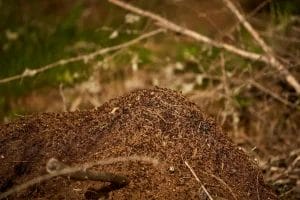 – Regularly inspect your property for signs of ant activity, such as ant trails or nests. Early detection can prevent infestations from getting out of control.
– Regularly inspect your property for signs of ant activity, such as ant trails or nests. Early detection can prevent infestations from getting out of control.
- Use monitoring traps or baits to track ant activity and identify the ant species present.
Targeted Pesticide Application:
– If ant infestations persist after implementing the above measures, consider using pesticides as a last resort. Choose environmentally friendly and targeted products that are specific to ants.
– Apply pesticides directly to ant trails or nests rather than widespread application, reducing the impact on non-target organisms.
Educational Outreach:
– Educate residents or employees about ant control practices and the importance of their participation in maintaining a pest-free environment.
By adopting Integrated Pest Management for ant control, you can effectively manage ant populations while minimizing the environmental impact and reducing the need for harsh chemical treatments. This approach not only promotes sustainability but also contributes to a healthier and safer living or working environment.
The Importance of Seasonal Ant Management for Pest-Free Home
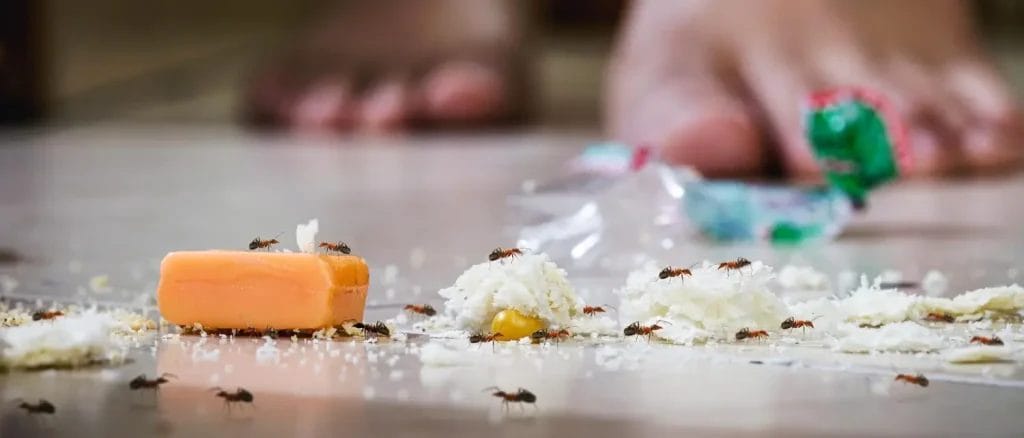
Seasonal ant management is crucial for effective pest control because ant behavior varies significantly with the changing seasons. Understanding these seasonal variations is essential to develop an effective strategy for prevention and treatment. Here’s a discussion on the importance of seasonal ant management and guidance on how to approach it:
Seasonal Variations in Ant Behavior:
Spring: Ants become more active in the spring as temperatures rise. They are in search of food sources to feed their growing colonies. Spring is a critical time for prevention as it’s when ant infestations often start. Look for ant trails, scout for nests, and address entry points early in the season.
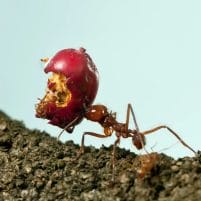 Summer: Ant activity peaks during the summer. They forage extensively for food, water, and building materials for their nests. You may notice more ant trails both indoors and outdoors. It’s important to focus on eliminating food sources and sealing entry points during this time.
Summer: Ant activity peaks during the summer. They forage extensively for food, water, and building materials for their nests. You may notice more ant trails both indoors and outdoors. It’s important to focus on eliminating food sources and sealing entry points during this time.
Fall: As temperatures start to drop, ants become less active. They prepare for the winter by reducing foraging. However, they may still enter homes in search of shelter. Fall is a good time for preventative measures like sealing cracks and crevices to prevent winter infestations.
Winter: Ant activity is at its lowest during winter, but some species remain active indoors. They seek warmth and food inside homes. Winter is an excellent time for indoor ant control efforts and identifying possible nest locations.
Seasonal Prevention and Treatment Routines:
Spring:
- Inspect and Seal: Conduct a thorough inspection of your property, both indoors and outdoors, for ant entry points. Seal cracks, gaps, and holes in foundations, walls, and windows.
- Remove Attractants: Clean up crumbs, spills, and food residues. Store food in airtight containers. Ants are attracted to sweets, proteins, and water sources.
- Outdoor Control: Use ant baits and barriers around your property, especially near entry points. Baits are most effective in the spring when ants are actively foraging.
 Summer:
Summer:
- Regular Cleaning: Maintain a clean home to eliminate food and water sources. Ants are more likely to invade if they find easy access to sustenance.
- Ant Baits: Continue to use ant baits and barriers as needed. Replace baits that have been consumed or dried out.
- Outdoor Maintenance: Trim vegetation away from your home to prevent ants from using plants as bridges to enter. Keep outdoor trash cans clean and secure.
Fall:
- Seal Gaps: Check for any new gaps or openings that ants might exploit as they seek shelter for the winter. Seal them promptly.
- Indoor Control: If you suspect ant nests indoors, consider using indoor baits, traps, or contacting a professional pest control service.
Winter:
- Monitor Indoor Activity: Keep an eye out for any signs of ant activity inside your home. Address any infestations promptly.
- Winterize Your Home: Ensure your home is well-insulated and sealed to prevent ants from entering.
Seasonal ant management is essential to effectively control ant infestations. By understanding how ant behavior changes with the seasons and implementing appropriate prevention and treatment routines, you can minimize the chances of ant problems in your home and maintain a pest-free environment year-round. If the infestation is severe or persistent, consider consulting with a pest control professional for targeted solutions.
Ant infestations are a common household problem that can be effectively managed with the right knowledge and strategies. By understanding ant behavior, practicing preventive measures, and considering professional assistance when necessary, you can ensure a pest-free environment for your home and family. Don’t let these tiny invaders disrupt your peace of mind – take proactive steps to control ant infestations and maintain a clean, safe living space.

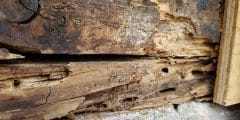
 Regularly clean and maintain kitchen and pantry areas to discourage ant foraging.
Regularly clean and maintain kitchen and pantry areas to discourage ant foraging.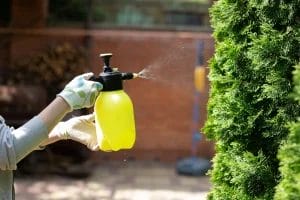 Unsuccessful DIY Efforts: If you’ve tried various DIY ant control methods, such as baits, traps, or sprays, and the infestation persists or worsens, it’s time to call in professionals who can identify the ant species and employ the most appropriate treatment methods.
Unsuccessful DIY Efforts: If you’ve tried various DIY ant control methods, such as baits, traps, or sprays, and the infestation persists or worsens, it’s time to call in professionals who can identify the ant species and employ the most appropriate treatment methods.